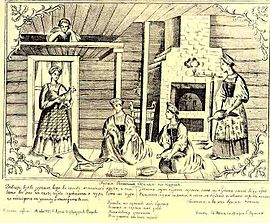A
| Part of a series on |
| Anthropology of religion |
|---|
 |
| Social and cultural anthropology |
- abacomancy /ˈæbəkoʊmænsi/ (also amathomancy): by dust (Hebrew ’ābāq, dust + Greek manteía, prophecy)
- acultomancy /əˈkʌltoʊmænsi/ (also acutomancy): by needles (from acutomancy below, influenced by Latin acus, needle, or acūleus, prickle or thorn)
- acutomancy /əˈkjuːtoʊmænsi/ → see acultomancy (Latin acus [acut-], needle + Greek manteía, prophecy)
- adromancy /ˈædroʊmænsi/ → see alomancy (from idromancy below, influenced by alomancy)
- adryomancy→ see hydromancy (metathesis of hydromancy)
- aeromancy /ˈɛəroʊmænsi/: by atmospheric conditions (Greek āēr, air + manteía, prophecy)
- agalmatomancy /əˈɡɔːlmətoʊmænsi/:[citation needed] by statues (Greek ágalma [agálmatos], statue + manteía, prophecy)
- aichmomancy /ˈɛkmoʊmænsi/: by sharp objects (Greek aikhmē, spearhead + manteía, prophecy)
- ailuromancy/aeluromancy → see theriomancy
- alectormancy/alectromancy /əˈlɛktroʊmænsi/: by rooster sacrifice (Greek alektor, rooster + manteía, prophecy)
- alectryomancy/alectoromancy: by rooster divination → see theriomancy
- aleuromancy¹ /əˈljʊəroʊmænsi/: by flour; see also chartomancy (Greek áleuron, meal + manteía, prophecy)
- alomancy/Halomancy /ˈæloʊmænsi/ (also adromancy): by salt (Greek háls, salt + manteía, prophecy)
- alphitomancy/ˈælfɪtoʊmænsi/: by barley (Greek alphis [alphit-], barley + manteía, prophecy)
- alveromancy /ælˈvɪəroʊmænsi/:[citation needed] by sounds
- amathomancy /ˈæməθoʊmænsi/ → see abacomancy by sand (Greek amathos, sandy soil + manteía, prophecy)
- ambulomancy /ˈæmbjʊloʊmænsi/: by walking (Latin ambulāre, to walk + Greek manteía, prophecy)
- amniomancy /ˈæmnioʊmænsi/: by placenta (Greek amniōn, amnion + manteía, prophecy)
- anemoscopy/anemomancy /ˌænɪˈmɒskoʊpi/: by wind (Greek anemos, wind + -skopiā, observation)
- anthomancy /ˈænθoʊmænsi/: by flowers (Greek anthos, flower + manteía, prophecy)
- anthracomancy /ˈænθrəkoʊmænsi/: by burning coals (Greek anthrax [anthrak-], charcoal + manteía, prophecy)
- anthropomancy /ænˈθrɒpoʊmænsi/: by human sacrifice (Greek anthrōpos, human being + manteía, prophecy)
- anthroposcopy /ænθroʊˈpɒskoʊpi/: by physical appearance (Greek anthrōpos, human being + -skopiā, observation)
- apantomancy /əˈpæntoʊmænsi/: by chance encounters with animals (Greek apantein, to encounter + manteía, prophecy)
- arachnomancy /əˈræknoʊmænsi/: by spiders (Greek arakhnē, spider + manteía, prophecy)
- archeomancy/archaeomancy /ˈɑːrkioʊmænsi/: by sacred relics (Greek arkhaios, ancient + manteía, prophecy)
- ariolation /ˌærioʊˈleɪʃən/: by altars (Latin ariolus, hariolus, prophet)
- arithmancy: assigning numerical value to a word or phrase
- armomancy /ˈɑːrmoʊmænsi/: by one's own shoulders (Latin armus, shoulder + Greek manteía, prophecy)
- Årsgång, archaic form of Swedish divination
- aruspicina: study of entrails[3]
- aspidomancy /ˈæspɪdoʊmænsi/: by sitting in a drawn circle or on a shield (Greek aspis [((transl|grc|aspid-], shield + manteía, prophecy)
- astragalomancy/astragalamancy → see cleromancy
- astragyromancy → see cleromancy (from astragalomancy above, perhaps influenced by Greek guros, spiral, circle, and therefore vertebra)
- astrapomancy /ˈæstrəpoʊmænsi/: by lightning (Greek astrapē, lightning flash + manteía, prophecy)
- astrology/astromancy/ /əˈstrɒloʊdʒi/: by celestial bodies (Greek astron, star + -logiā, study). This method was widespread in medieval period, particularly in Mesopotamia. [4]
- augury /ˈɔːɡjʊəri/ → see theriomancy
- auramancy /ˈɔːrəmænsi/: by auras (Greek aurā, breath + manteía, prophecy)
- auspicy/auspication → see theriomancy (Latin avis, bird + specere, to look at)
- austromancy → see theriomancy /ˈɔːstroʊmænsi/: by wind (Latin auster, south wind + Greek manteía, prophecy)
- avimancy → see orniscopy (Latin avis, bird + Greek manteía, prophecy)
- axiomancy/axinomancy /ˈæksioʊmænsi/: by axes (Latin axis, axis + manteía, prophecy)
